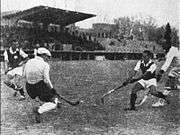Apostolos Nikolaidis Stadium
Coordinates: 37°59′13.81″N 23°45′15.10″E / 37.9871694°N 23.7541944°E
| Leoforos | |
|
| |
| Location | 160 Alexandras Avenue, Ambelokipi, Athens, Greece |
|---|---|
| Owner | Panathinaikos AC |
| Operator | Panathinaikos AC/Panathinaikos FC |
| Capacity | 16,003 [1] |
| Surface | Grass |
| Scoreboard | Yes |
| Construction | |
| Opened | 1922 |
| Renovated | 2001, 2007, 2013 |
| Construction cost |
7,000,000 € (2001 Renovation) 800,000 € (2007 Renovation) 2,000,000 € (2013 Renovation) |
| Tenants | |
|
| |
Apostolos Nikolaidis Stadium (Greek: Στάδιο Απόστολος Νικολαΐδης) is a football stadium and multi-sport center in Athens, Greece. It was inaugurated in 1922 and is the oldest football stadium in Greece currently active. It is the traditional athletic center of Panathinaikos A.C. and has been the home ground of Panathinaikos FC for the most part of the club's existence.
The stadium is named after the historic club's president, official and athlete Apostolos Nikolaidis. It is situated in the Ambelokipi district of Athens, east of the Lycabettus Hill and on Alexandras Avenue 160, by which name it is most commonly known (Leoforos Alexandras or simply Leoforos, Leoforos meaning Avenue). The stadium's record attendance was recorded in 1967, when 29,665 spectators watched the Cup Winners Cup game between Panathinaikos and FC Bayern Munich.
It also houses several other facilities under its stands, including an indoor hall, a small swimming pool, a boxing ring, an indoor shooting range, the club's offices as well as various other facilities.
History

Apostolos Nikolaidis Stadium holds a very important place in the history of Greek football. The first stand was built in 1928, and for almost 50 years it hosted the majority of big matches in domestic and international competitions. It was the first to have floodlights installed (1938) and the first with a grass pitch (1958). It was the home of the Greek national football team for many years.
Panathinaikos FC left Leoforos in 1984 and moved to the Olympic Stadium. The club returned to their home ground in 2001, following an upgrading that cost €7 million.
In 2007, Panathinaikos FC decided to reuse Apostolos Nikolaidis Stadium for the 2007/2008 Greek Super League season.
Due to the stadium's old construction, dearth of space and dense urbanization of the area, the club has sought to move. Negotiations were under way between the Greek government, the Municipality of Athens, and the football, basketball, volleyball and amateur divisions of the club in order to facilitate the building of a new, comprehensive sports complex to house all of the 21 departments of Panathinaikos elsewhere. Finally, the industrial Votanikos district has been selected among others to house the complex and there are plans for the construction to begin in 2008. Athens Mayor Dora Bakoyianni has stated that such a project will revitalise the area as well as benefit the club.
In 2012, bureaucracy problems, such as Panathinaikos' and the country's bad financial situation due to the economic crisis, haven't allowed the construction of the new stadium. President Giannis Alafouzos decided to move the team back from the Athens Olympic Stadium to the historical Leoforos Alexandras for the 2013-14 season. As of October 2013, the plans for the construction of the Votanikos complex have been put on hold.
The current President of the club, Giannis Alafouzos, declared his intention for another renovation of the stadium and the capacity increase, while the Panathinaikos Movement made its propositions for a total reconstruction.
Pavlos Giannakopoulos Indoor Hall
Under the East curve of the stadium, under Gates 6 and 7, there is an Indoor Hall. When it was constructed in 1959, it was the first indoor hall in Greece. It has a capacity of 2,000[2] and it is famous for the hot atmosphere Panathinaikos fans create in it. It's known by its nickname: "The Indian's Tomb", pronounced "Tafos tou Indou" in Greek. It was called like that during its inauguration ceremony by Tasos Stefanou,[3] curator of the basketball department at the time, as the claustrophobic feeling it created reminded him of the namesake film by Fritz Lang, that was featured in cinemas during the same time. This nickname was so successful, that it was immediately adopted and is used until today to -informally- distinguish the indoor hall from the other facilities of the stadium.
Since 2015, the official name of the indoor hall is "Pavlos Giannakopoulos", in honour of the historic president of Panathinaikos B.C.
Other facilities
Apart from the football field and the indoor hall, the stadium is also the home ground of the most sport departments of Panathinaikos, such as the rugby, boxing, fencing, archery, table-tennis, wrestling, weightlifting and shooting departments. There are training rooms, boxing ring, swimming pool, such as an official shop of the football team, pressroom and various cafés.
Gate 13
Fan seating in Greece is segregated by team allegiance. Gate 13, the subject of much graffiti in Athens, is where the most enthusiastic supporters of Panathinaikos FC sit in the stadium. Gate 13 is known for creating one of the best atmospheres throughout Europe as the stadium has the fans seated directly next to the field and the endless singing even during negative results continuously pushes players to give their maximum. The association of Gate 13 was founded on 19 November 1966 and is the oldest union of fans in Greece.
Images
-
Entrance to the archery, fencing and table-tennis departments
-
Entrance to the boxing department
-
"Pavlos Giannakopoulos Indoor Hall"
-

Panathinaikos shop
References
- ↑ "Archived copy". Archived from the original on 2013-10-05. Retrieved 2013-10-04.
- ↑ Ο Γκάλης, ο Ντράζεν, ο Μαρτίν και οι άλλοι (Greek).
- ↑ "Βραδιά αναμνήσεων στον "Τάφο του Ινδού"". sport24.gr.
External links
- "Apostolos Nikolaidis" stadium History and photos at stadia.gr (in English)
| Wikimedia Commons has media related to Apostolos Nikolaidis Stadium. |